Discover the radiant spectrum of avian elegance as we delve into the realm of 14 Birds With Yellow Bellies. From the sunlit canopies to the grassy meadows, these feathered wonders add a splash of colour to the natural canvas.
Each bird, with its distinctive hues and behaviours, contributes to the symphony of nature.
In this exploration, we’ll unveil the stories of diverse species like warblers, orioles, and flycatchers, each adorned with a vibrant yellow belly.
Their striking presence is not just a visual delight but also a testament to the intricate ecosystems they inhabit.
Join us on a journey through the lively habitats and intricate behaviours of these 14 avian marvels, and gain a deeper appreciation for the kaleidoscope of life that unfolds beneath the canopy of their yellow-bellied charm. Stay focused.
14 Birds With Yellow Bellies
Jump on a colourful avian journey as we explore the vibrant world of birds with yellow bellies.
From the melodious songs of warblers to the bold plumage of orioles and the sleek elegance of waxwings, each species brings its unique charm to the avian tapestry.
1. Canada Warbler
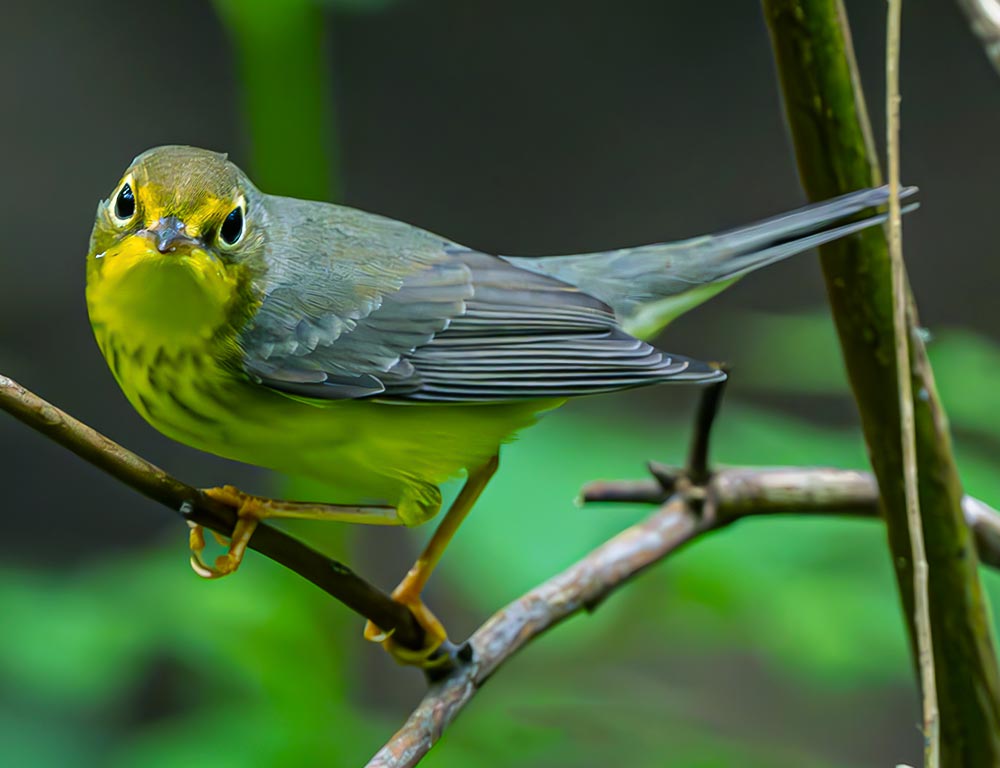
- Scientific name: Cardellina canadensis
- Category: Songbird
- Population: Stable, though some populations may be declining
- Life span: 7-10 years
- Size: 5.1-5.5 inches (13-14 cm)
- Weight: 0.4-0.5 ounces (11-14 grams)
- Status: Least Concern (on the IUCN Red List)
The Canada Warbler is a charming songbird known for its striking yellow underparts, contrasting with greyish-blue upperparts.
Found in North America during the breeding season, these birds migrate to South America for the winter. Their habitat includes dense, moist woodlands where they forage for insects and spiders.
The Canada Warbler is an agile insectivore, flitting through the lower branches of trees and shrubs to catch its prey.
It builds cup-shaped nests on or near the ground, often hidden in vegetation. These birds face threats from habitat loss due to deforestation and climate change affecting their wintering grounds.
2. Western Kingbird
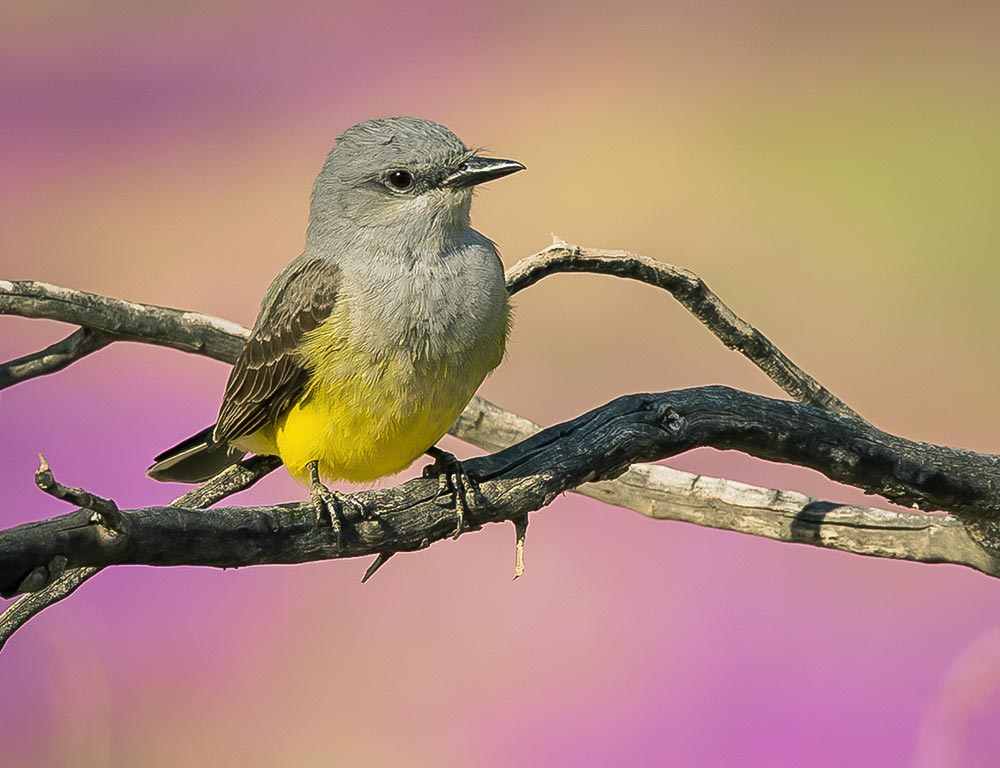
- Scientific name: Tyrannus verticalis
- Category: Flycatcher
- Population: Stable
- Life span: 3-5 years
- Size: 7.5-9 inches (19-23 cm)
- Weight: 1.3-1.6 ounces (37-45 grams)
- Status: Least Concern
The Western Kingbird is a bold, yellow-bellied flycatcher with a black tail tip and a conspicuous white band on its tail.
These birds are widespread in North and South America, preferring open habitats like fields, meadows, and agricultural areas.
Western Kingbirds are known for their aerial acrobatics while hunting insects. They perch prominently on exposed branches or utility wires, sallying forth to catch flying insects.
These birds also protect their nests, using aerial displays to deter potential threats. While adaptable to human-altered landscapes, they are susceptible to pesticide exposure.
3. American Goldfinch
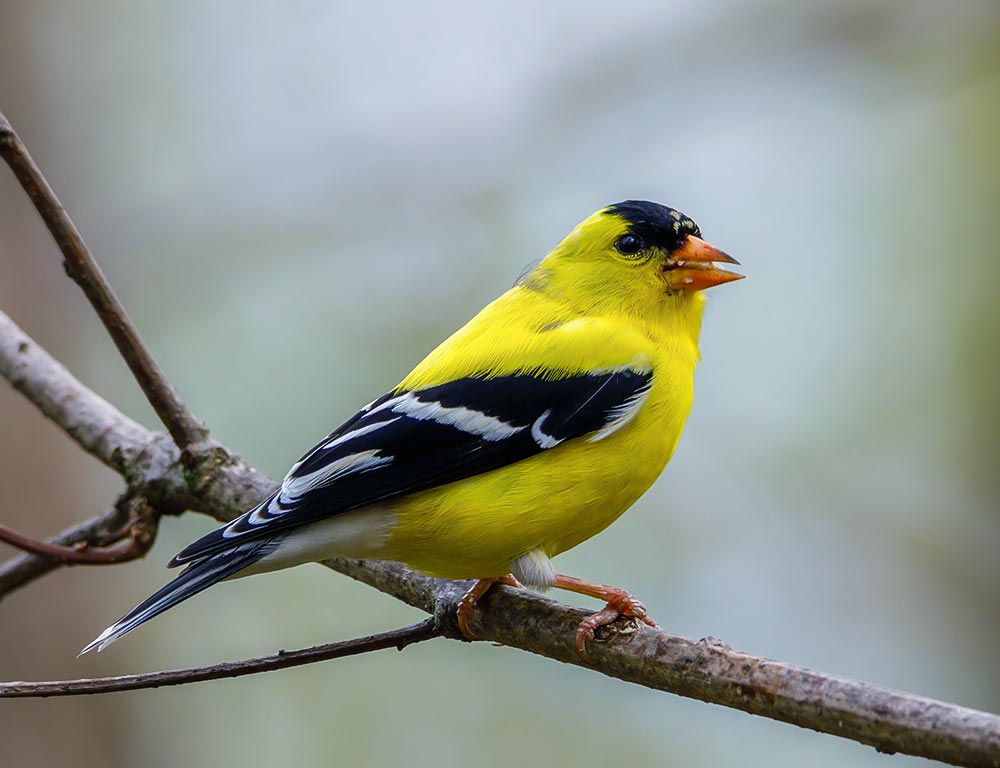
- Scientific name: Spinus tristis
- Category: Finch
- Population: Large and stable
- Life span: 6-7 years
- Size: 4.3-5.5 inches (11-14 cm)
- Weight: 0.39-0.71 ounces (11-20 grams)
- Status: Least Concern
The American Goldfinch is a vibrant yellow bird with black wings and a distinctive black cap during the breeding season. They are found throughout North America, often in weedy fields, meadows, and gardens.
American Goldfinches are granivores, primarily feeding on seeds, especially from thistle plants.
They are acrobatic feeders hanging upside down to extract seeds. During the breeding season, males sing a cheerful, musical song to attract mates.
Their nesting season aligns with the availability of thistledown for nest construction. These adaptable birds are common in suburban and urban environments.
4. Audubon’s Oriole
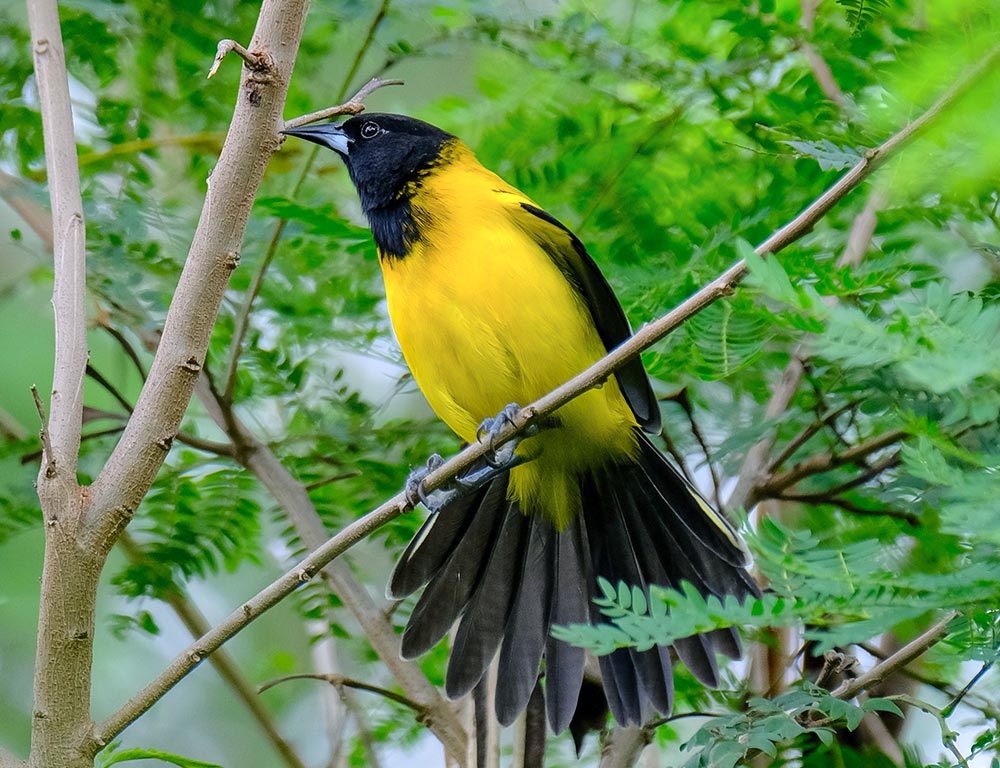
- Scientific name: Icterus graduacauda
- Category: Oriole
- Population: Stable, but regional populations may be declining
- Life span: 8-10 years
- Size: 8-9 inches (20-23 cm)
- Weight: 1.2-1.4 ounces (34-40 grams)
- Status: Least Concern
Audubon’s Oriole is a striking bird with a bright yellow body and black wings. Endemic to the Lower Rio Grande Valley in Texas and northeastern Mexico, these orioles inhabit subtropical woodlands and riparian areas.
They are skilled foragers, feeding on insects, fruits, and nectar. Audubon’s Orioles are known for their hanging, basket-like nests suspended from the outer branches of trees.
While not currently considered globally threatened, habitat destruction and fragmentation pose risks to localized populations. Conservation efforts focus on preserving their unique habitat and raising awareness about their needs.
5. Western Tanager
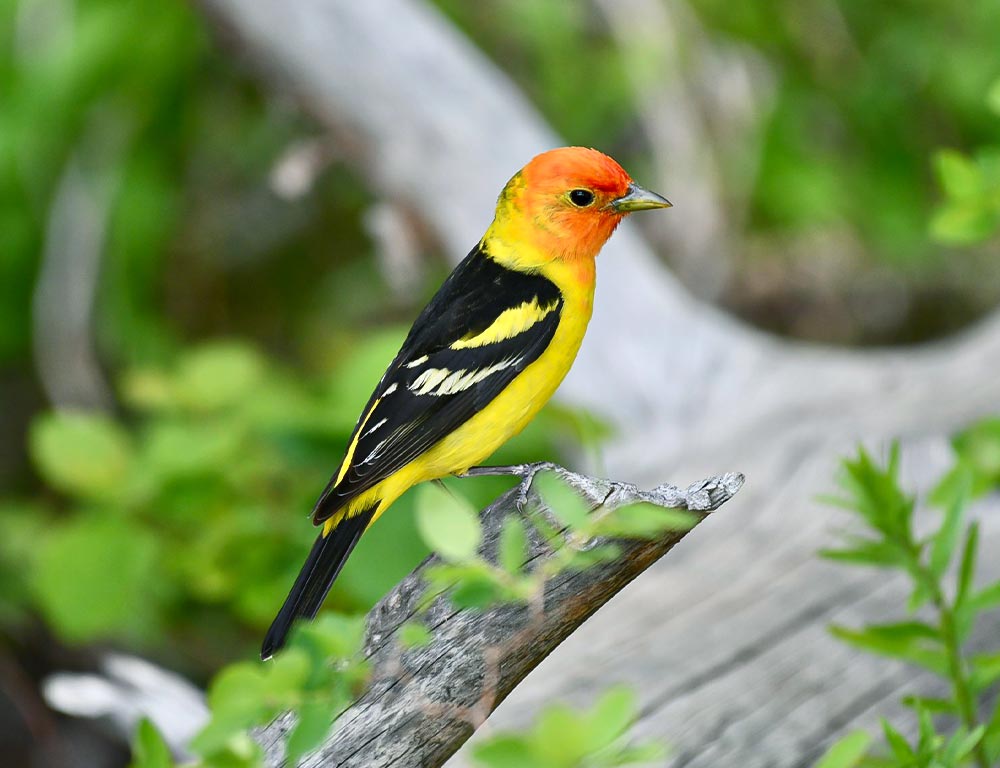
- Scientific name: Piranga ludoviciana
- Category: Tanager
- Population: Stable
- Life span: 5-7 years
- Size: 7.1-8.3 inches (18-21 cm)
- Weight: 0.7-1.1 ounces (20-31 grams)
- Status: Least Concern
The Western Tanager is a stunning bird with bright yellow plumage, black wings, and a reddish-orange head.
Found in western North America, these tanagers inhabit coniferous and mixed forests during the breeding season and migrate to Central America for the winter.
Western Tanagers are primarily insectivores, foraging in the treetops and catching insects in flight. They are known for their distinctive call notes and melodious songs.
Despite their vibrant appearance, Western Tanagers can be elusive as they move high in the forest canopy. Conservation efforts focus on protecting their breeding and wintering habitats.
6. Common Yellowthroat
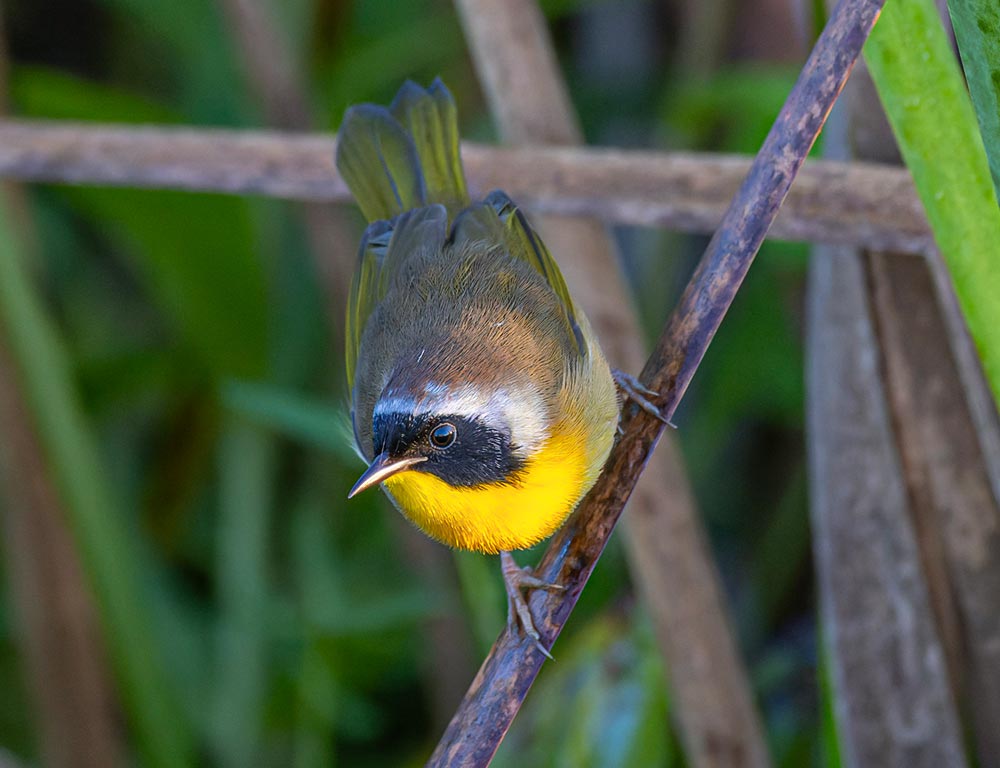
- Scientific name: Geothlypis trichas
- Category: Warbler
- Population: Large and widespread
- Life span: 3-6 years
- Size: 4.3-5.1 inches (11-13 cm)
- Weight: 0.3-0.4 ounces (9-12 grams)
- Status: Least Concern
The Common Yellowthroat is a small, lively warbler with a yellow throat and distinctive black mask.
Found throughout North America, these birds inhabit various wetland habitats, including marshes, and are often found in dense vegetation.
Common Yellowthroats feed on insects, spiders, and small berries. They are ground-nesters, building cup-shaped nests hidden in tall grasses or low shrubs.
Males are known for their cheerful “witchy-witchy” songs. These adaptable warblers can be found in natural and human-altered landscapes.
7. Eastern Meadowlark
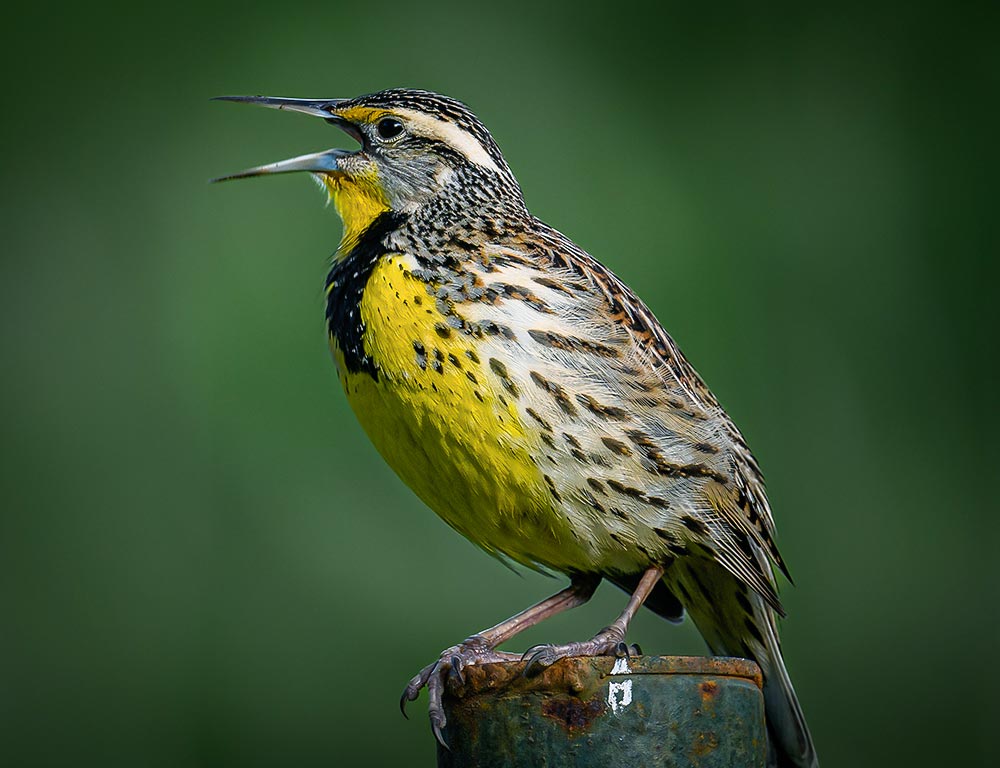
- Scientific name: Sturnella magna
- Category: Blackbird
- Population: Declining in some regions
- Life span: 4-5 years
- Size: 8.5-11 inches (22-28 cm)
- Weight: 4.2-6 ounces (120-170 grams)
- Status: Near Threatened
The Eastern Meadowlark is a ground-dwelling songbird with a bright yellow breast and a distinctive black “V” on its chest.
Found in grasslands and open fields across eastern North America, these meadowlarks are known for their melodious songs and conspicuous display flights.
Eastern Meadowlarks feed on insects, seeds, and small fruits. Loss of grassland habitats due to agricultural intensification and urbanization threatens their populations.
Conservation efforts aim to preserve and restore grasslands while addressing the specific needs of Eastern Meadowlarks.
8. Great Crested Flycatcher
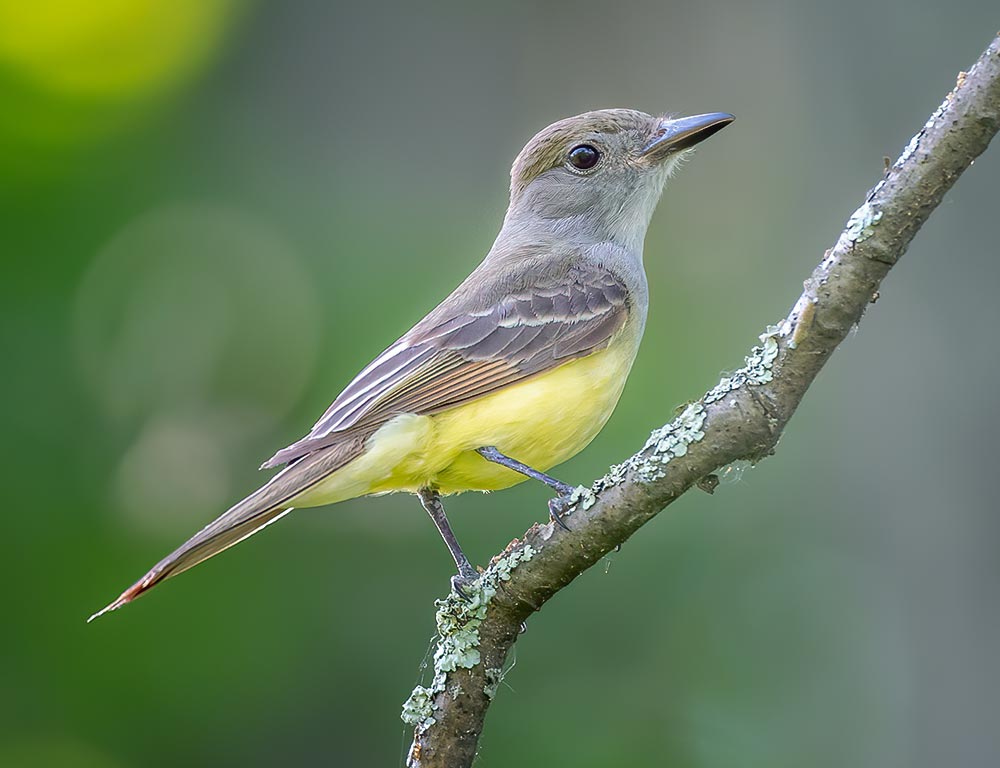
- Scientific name: Myiarchus crinitus
- Category: Flycatcher
- Population: Stable
- Life span: 3-10 years
- Size: 7.5-8.7 inches (19-22 cm)
- Weight: 1.2-1.5 ounces (34-42 grams)
- Status: Least Concern
The Great Crested Flycatcher is a striking bird with bright lemon-yellow underparts and a rusty-orange tail.
Found in deciduous forests across eastern North America, these flycatchers are skilled hunters of insects, including bees, wasps, and beetles.
Great Crested Flycatchers are cavity-nesters, often utilizing abandoned woodpecker holes for nesting. They are vocal birds with a distinctive “wheep” call.
Their nesting habits and insect-rich diet make them valuable for controlling pest populations. Conservation efforts focus on maintaining mature forests with suitable nesting sites for these flycatchers.
9. Yellow Warbler
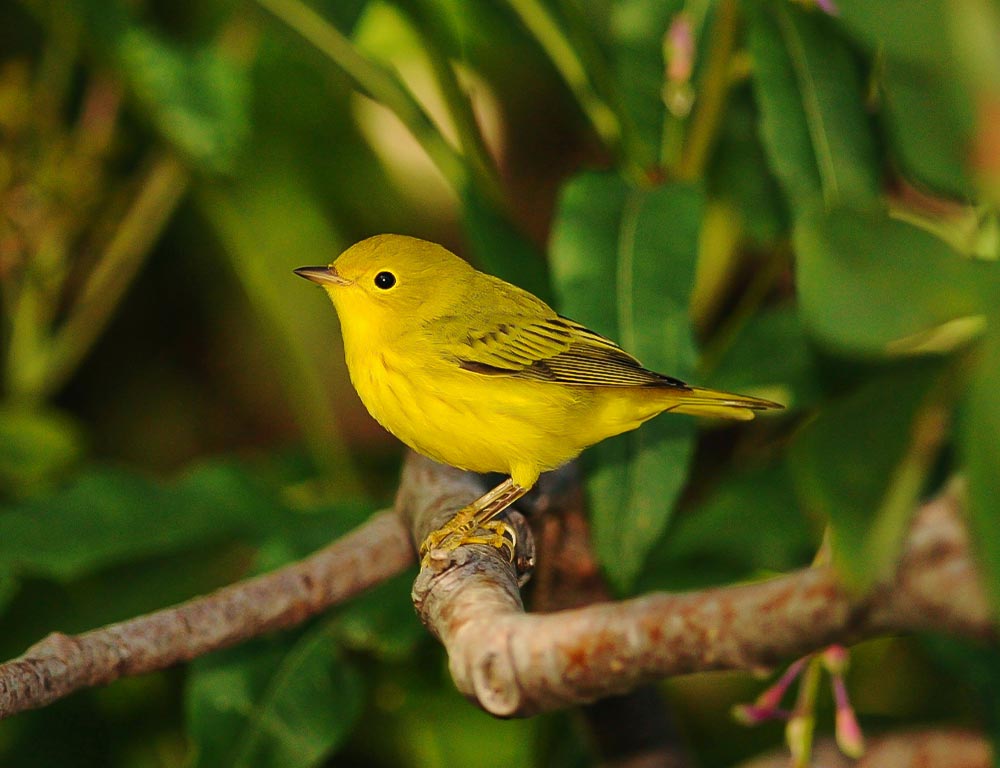
- Scientific name: Setophaga petechia
- Category: Warbler
- Population: Abundant and widespread
- Life span: 6-10 years
- Size: 4.7 inches (12 cm)
- Weight: 0.3-0.4 ounces (9-11 grams)
- Status: Least Concern
The Yellow Warbler is a small, lively warbler with bright yellow plumage and, in males, reddish streaks on the chest.
Found across North America, these warblers inhabit various habitats, including shrubby areas, wetlands, and gardens.
Yellow Warblers are primarily insectivores, foraging for insects, spiders, and caterpillars among leaves and branches. They build cup-shaped nests in shrubs, often in close proximity to water.
These warblers are known for their sweet, musical song, and their widespread distribution makes them a familiar and welcome sight for birdwatchers.
10. Evening Grosbeak
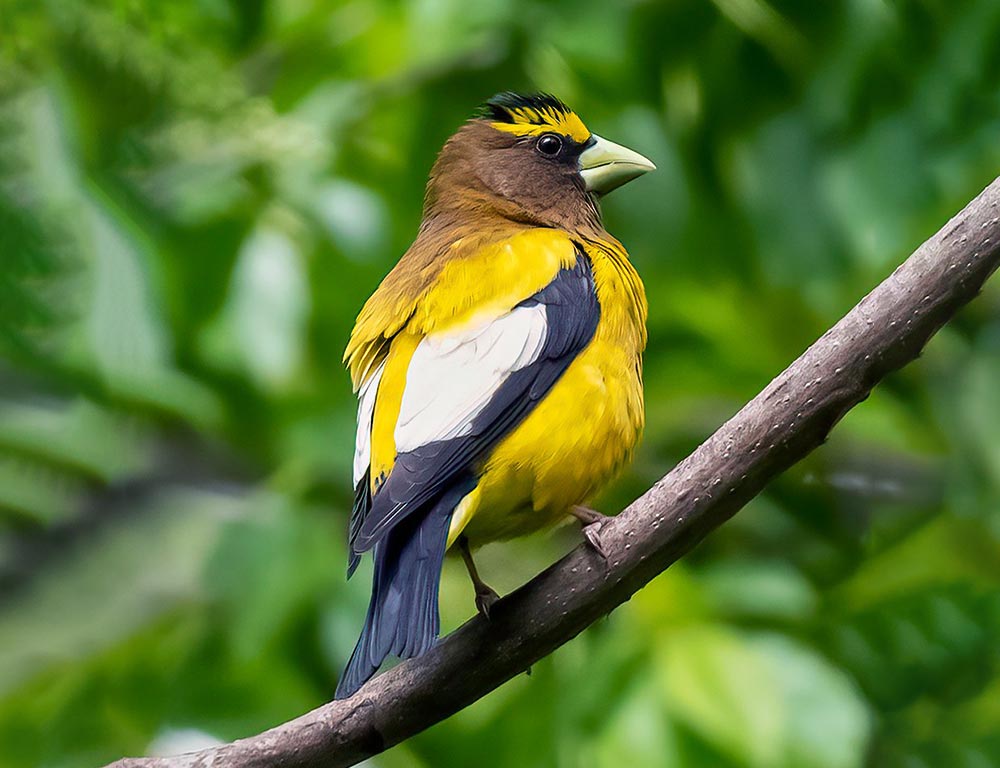
- Scientific name: Coccothraustes vespertinus
- Category: Finch
- Population: Declining in some regions
- Life span: 7-10 years
- Size: 6.7-8.7 inches (17-22 cm)
- Weight: 1.8-3.0 ounces (50-85 grams)
- Status: Least Concern (on the IUCN Red List)
The Evening Grosbeak is a striking bird with bright yellow plumage, black wings, and a massive, conical bill. These grosbeaks are found in North America and inhabit coniferous and mixed forests and urban and suburban areas.
Evening Grosbeaks are primarily seed-eaters, with a preference for sunflower seeds. They often visit bird feeders in large, noisy flocks.
Despite their striking appearance, Evening Grosbeak populations are declining in some areas, possibly due to habitat loss and changes in food availability.
Conservation efforts focus on understanding their ecology and mitigating potential threats.
11. Magnolia Warbler
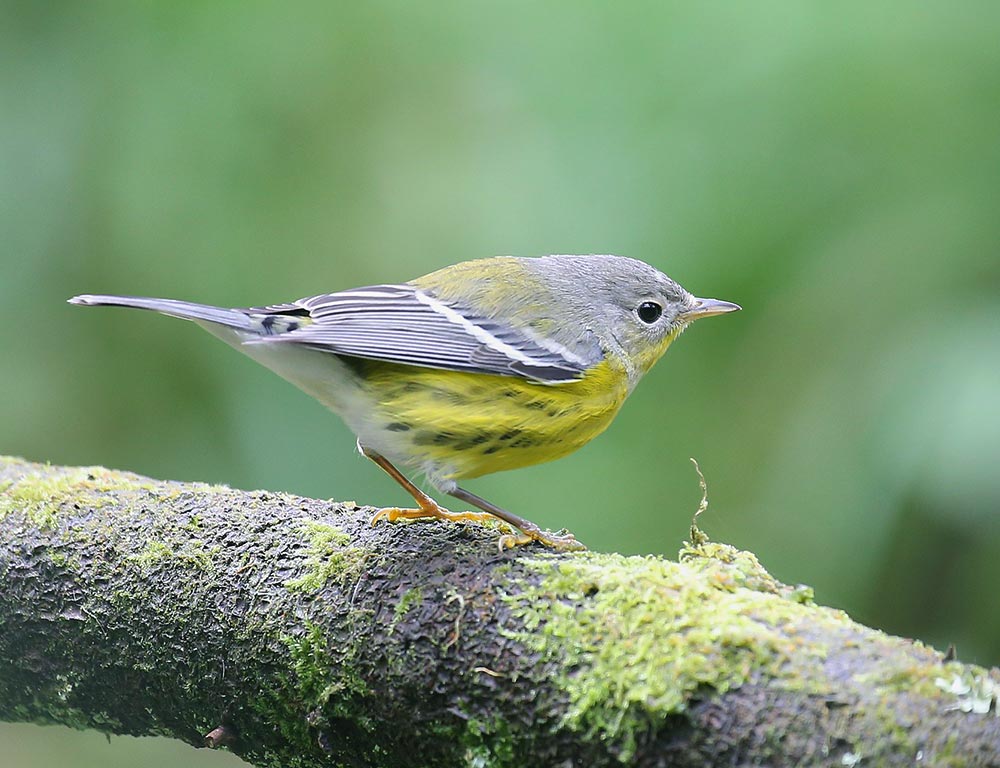
- Scientific name: Setophaga magnolia
- Category: Warbler
- Population: Stable
- Life span: 2-5 years
- Size: 4.3-5.1 inches (11-13 cm)
- Weight: 0.3-0.5 ounces (9-14 grams)
- Status: Least Concern
The Magnolia Warbler is a colourful songbird with bright yellow underparts, a black necklace, and striking black and white markings on the wings.
Found in North America during the breeding season, these warblers migrate to Central America for the winter.
Magnolia Warblers forage for insects, spiders, and berries in the canopy of mixed woodlands. They build cup-shaped nests in the lower branches of trees.
Known for their energetic and constantly moving behaviour, Magnolia Warblers add vibrancy to the forested landscapes they inhabit. Conservation efforts focus on preserving their breeding and wintering habitats.
12. Cedar Waxwing
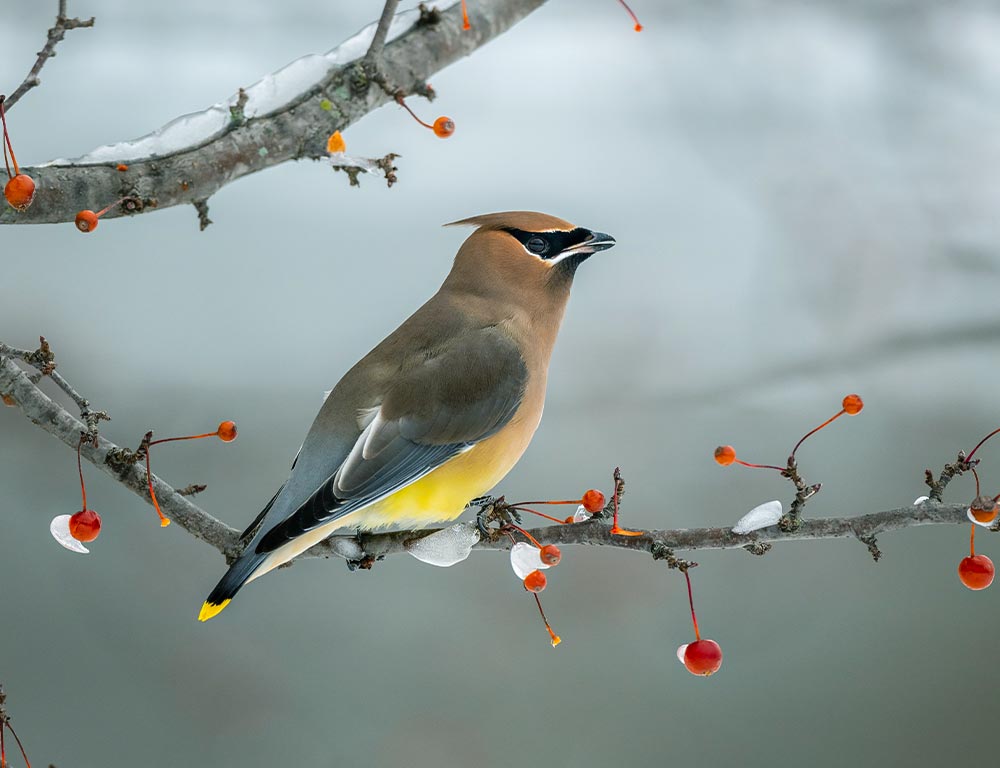
- Scientific name: Bombycilla cedrorum
- Category: Waxwing
- Population: Stable
- Life span: 5-7 years
- Size: 6.3-7.9 inches (16-20 cm)
- Weight: 1.1-1.4 ounces (32-40 grams)
- Status: Least Concern
The Cedar Waxwing is a sleek, crested bird with distinctive silky plumage in shades of brown, gray, and yellow.
Found in North America, these waxwings inhabit various wooded habitats, often forming large flocks during the non-breeding season.
Cedar Waxwings are frugivores, primarily feeding on fruits, berries, and insects. They are known for their unique feeding behaviour, passing berries from one bird to another in a social display known as “gifting.”
These birds are skilled fliers and are recognizable by the yellow tip on their tail feathers. Conservation efforts focus on preserving habitats with abundant fruiting trees and shrubs.
13. Great Kiskadee
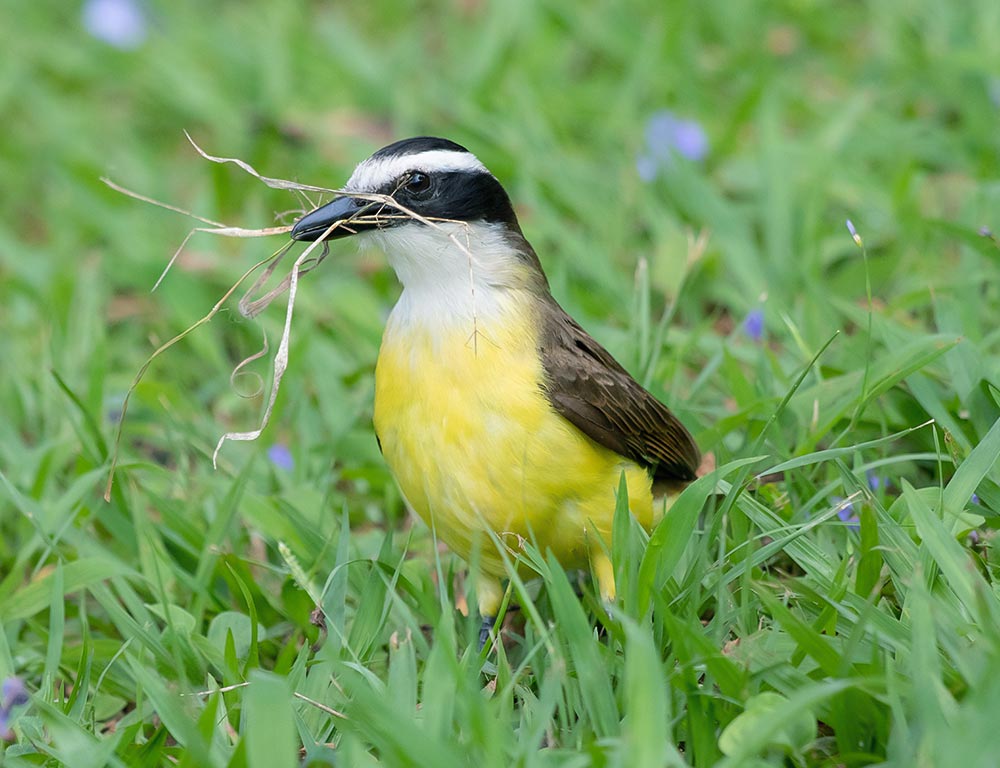
- Scientific name: Pitangus sulphuratus
- Category: Flycatcher
- Population: Stable
- Life span: 5-8 years
- Size: 8.7-11 inches (22-28 cm)
- Weight: 1.5-2.5 ounces (42-71 grams)
- Status: Least Concern
The Great Kiskadee is a large, bold flycatcher with a vibrant yellow belly, black and white head markings, and a distinctive white eye stripe.
Found in the Americas, these kiskadees inhabit various environments, including open woodlands, urban areas, and wetlands.
Great Kiskadees are opportunistic feeders, consuming a varied diet of insects, small vertebrates, and fruits. They are known for their loud and repetitive calls that sound like their name, “kis-ka-dee.”
These adaptable birds have successfully colonized human-altered landscapes. Conservation efforts focus on maintaining diverse habitats and addressing potential threats from habitat destruction.
14. Altamira Oriole
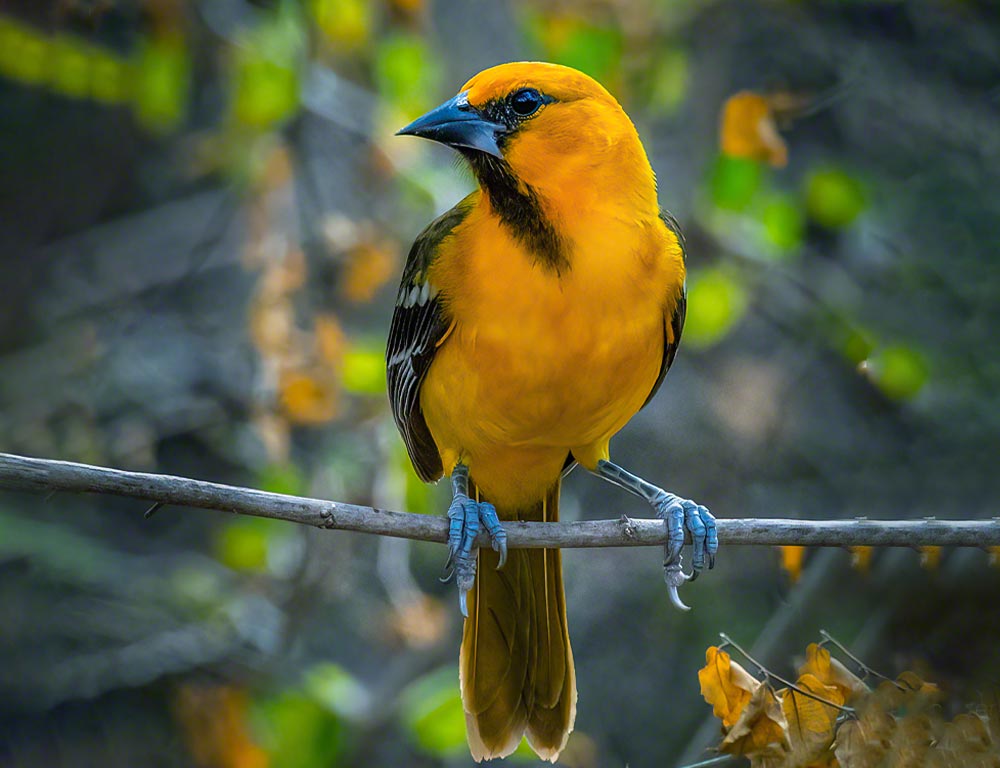
- Scientific name: Icterus gularis
- Category: Oriole
- Population: Stable
- Life span: 6-10 years
- Size: 9.1-10.2 inches (23-26 cm)
- Weight: 1.8-2.3 ounces (51-65 grams)
- Status: Least Concern
The Altamira Oriole is a striking bird with bright orange-yellow plumage and a black face mask. Endemic to Mexico and Central America, these orioles inhabit various habitats, including forests, savannas, and urban areas.
Altamira Orioles are omnivores, feeding on nectar, fruits, insects, and spiders. They are known for their elaborate hanging nests, often woven from palm fibres. Males are vocal, producing a series of whistled notes.
While not currently globally threatened, conservation efforts aim to monitor populations and protect their diverse range of habitats from potential threats.
Wrapping Up
In the symphony of nature, birds with yellow bellies play a harmonious role, enchanting us with their vibrant colours and diverse lifestyles.
From the energetic warblers weaving through dense foliage to the sleek elegance of waxwings, each species paints a vivid stroke on the canvas of our skies.
The lively kiskadee, the oriole’s intricate nests, and the cooperative feeding rituals of cedar waxwings reveal the fascinating facets of avian existence.
As we immerse ourselves in the world of these yellow-bellied wonders, it becomes clear that their survival is intricately linked to preserving diverse habitats.
Their challenges, from habitat loss to changing climates, emphasize the delicate balance needed for their continued flourishing.
Discover the captivating stories behind these feathered marvels and gain a deeper appreciation for the importance of conservation efforts.
Let the vibrant hues of these birds with yellow bellies inspire a commitment to safeguarding the rich biodiversity that graces our skies and enriches our natural world. Best wishes.